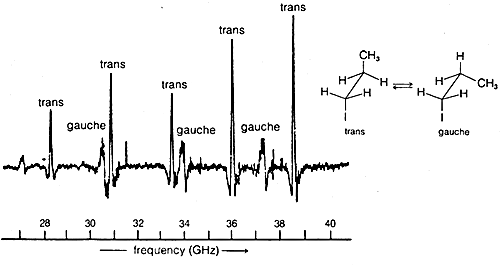9.7: Microwave (Rotational) Spectra
- Page ID
- 22224
Rotational energy levels normally are very closely spaced so low-energy radiation, such as is produced by radio transmitters operating in the microwave region, suffices to change molecular rotational energies. Because electronic and vibrational energy levels are spaced much more widely, and because changes between them, are induced only by higher-energy radiation, microwave absorptions by gaseous substances can be characterized as essentially pure “rotational spectra.” It is possible to obtain rotational moments of inertia from microwave spectra, and from these moments to obtain bond angles and bond distances for simple molecules.
An example of the use of microwave spectra is provided by Figure 9-8, which shows separate rotational absorptions observed for trans and gauche conformations of propyl iodide (cf. Section 5-2).
Although microwave spectroscopy, being confined to gases, is not a routine method in the organic laboratory, it is important to us here in setting the stage for the consideration of more complex absorptions that occur with infrared radiation.



